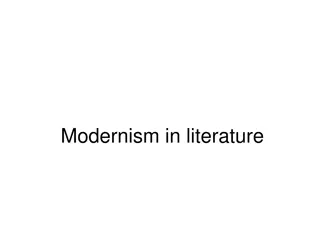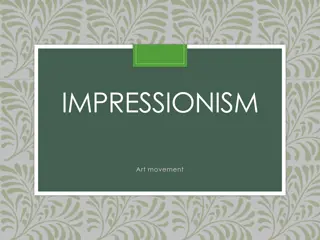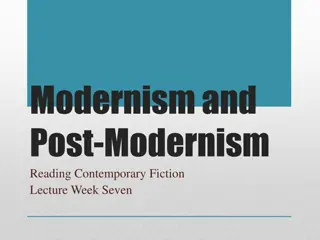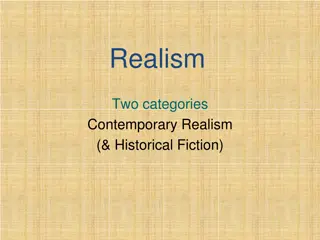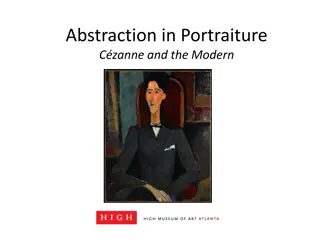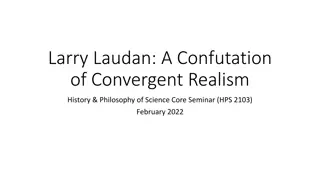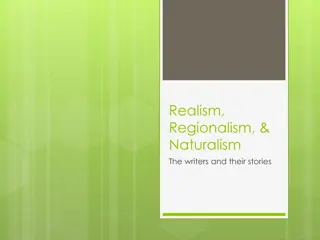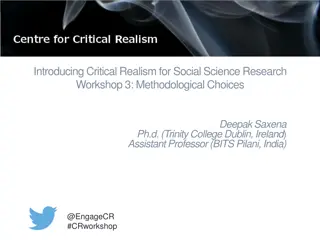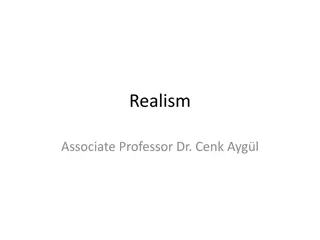Exploring Realism in Literature: A Journey through the Realistic Novel Movement
Realism in literature, originating in the mid-19th century in France and Russia, aimed to portray life authentically, devoid of idealistic elements. This introduction delves into how realistic novels focus on ordinary characters in everyday situations, steering clear of fantasy. Writers like Flaubert, Chekhov, Eliot, Twain, and Howells became prominent for their realistic portrayals, emphasizing details and striving for a genuine reflection of reality without bias or commentary.
- Realism in Literature
- Realistic Novel Movement
- Character Portrayal
- Authentic Representation
- 19th Century Fiction
Download Presentation

Please find below an Image/Link to download the presentation.
The content on the website is provided AS IS for your information and personal use only. It may not be sold, licensed, or shared on other websites without obtaining consent from the author. Download presentation by click this link. If you encounter any issues during the download, it is possible that the publisher has removed the file from their server.
E N D
Presentation Transcript
Realistic Novel Introduction: Realism in literature - associated with the realist art movement. Emerged during mid-19thcentury in France and Russia Response to classical demands of creative writings. attempted to show life as it should be as well as against the idealistic conceptions of Romantic writings. Firstly used by Friedrich Schiller in his letter to Goethe.
term is applied to the works of literature dealing with the new approach to character and subject matter, where stories reflect real life The term is applied to the works of literature that deal with the new approach to character and subject matter stories reflect real life and fictional characters as if they are real characters. No place for fantasy and supernatural Instead, it represents common people and their different day to day activities, joys, sorrows, successes, and failures.
e.g. The Human Comedy a realistic portrait of all aspects of France of his time characters portrayed therein are from the lowest thief or prostitute to the highest aristocrat or political leader. First work that can be called truly realistic is the work of Gustave Flaubert (France), Anton Chekhov (Russia), George Eliot (England), and Mark Twain and William Dean Howells ( the USA). Their novels deal with the complex characters with mixed motives that are rooted in social class and operate according to a highly developed social structure.
Attention is given to details and an effort is made to replicate the true nature of reality in a way that novelists had never attempted before. Novel s function : simply to report what happens, without comment or judgment. Characters in a realistic novel interact with other characters and undergo plausible and everyday experiences. Novel s function : simply to report what happens, without comment or judgment.
Definitions: A type of novel characterized as the fictional attempt to give the effect of realism by representing complex characters with mixed motives who are rooted in a social class, operate in a highly developed social structure, interact with many other characters, and undergo plausible and everyday modes of experience. Abrams Glossary of Literary Terms *A type of novel that places a strong emphasis on the truthful representation of the actual in fiction. Holman s Handbook to Literature
* There is a kind of novel which in fact creates and judges the quality of a whole way of living in terms of the qualities of persons. . . . it offers a valuing creation of a whole way of life, a society, that is larger than any of the individuals composing it, and at the same time valuing creations of individual human beings . . . Neither element, neither the society nor the individual, is there as a priority. The society is not a background against which the personal relationships are studied, nor are the individuals merely illustrations of aspects of the way of life. I call this the realistic tradition . . . Raymond Williams
Features of the Realistic Novel: 1. Objectivity and fidelity: objectivity and fidelity to facts. Many writers of the period had concurrent occupations in the publishing industry Use of journalistic technique to represent the everyday reality with detailed descriptions of the surrounding world they had witnessed.
2. Docudrama: characters and events are intended to seamlessly reproduce the real world. growing concern with the plight of the less fortunate in society New subjects typical subject : upwardly mobile middle class performing to retain their position in the world
3.Portrayal of human psychology: represent the inner workings of the mind, and the delicate play of emotions. Portrayal of complicated human consciousness human mind there are very few absolutes which help in shaping a new sensibility of the human world. belief in the concept that people are neither completely good nor completely bad, but somewhere on the spectrum.
4.Complex Characters: intricate and layered characters who, feel as though they could be flesh and blood creatures. internal monologues and a keen understanding of human psychology. individual is composed of a network of motivations, interests, desires, and fears. Changes in mood, perceptions, opinions and ideas constitute the turning points or climaxes.
5.Plot Structure: destroyed the established form of plot structure which presents the notion of a systematic outline that follows a definite arc of events, with an identifiable climax and resolution. Realistic novelists observe that life does not follow such patterns, so for them, neither should the novel. Instead of grand happenings, tragedies and epic turns of events, the realistic novel plods steadily over a track not greatly disturbed by external circumstances.
6.Narrative Style: experimentation with Narrative style Instead of an omniscient narrator calmly describing the persons and events, readers often confront unreliable narrators who do not have all the information. Often, the narrators perceptions are coloured by their own prejudices and beliefs. story inside a story




